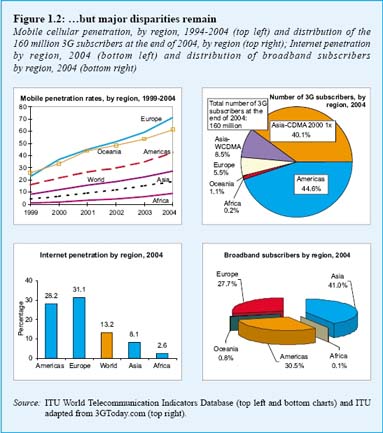It’s been monts since last ITU’s World Telecommunication/ICT Development Report saw the light, but it’s not been until an accurate reading to prepare my tomorrow’s seminars that I realized the following statement:
ITU statistics show that over the last 10 years, the digital divide between the developing and the developed countries has been narrowing in terms of fixed telephone lines,
mobile subscribers and Internet users.
This was also stated by this year’s e-Readiness Rankings and I then disagreed. But now, now I got data.
As can be seen, digital divide comparisons among developed and developing countries are relative, in %. According to this, its true: digital divide is narrowing. In 1994, mobile penetration for developing countries was about to 5% and less than 0.2% for developing ones. With a 77% penetration in 2004, developed countries have “just” four times mobile penetration than developing (19%). But take a closer look. In 1994, developed countries were almost 5 points ahead than developing in mobile penetration. Ten years later, they are 58 points ahead. If we look it this way, in absolute terms, the digital divide has widened 11 times the existing gap.
For fixed lines, either the way you look at it, the divide has narrowed, though the relative approach or the absolute one differs slightly. While the first one shows a very important decrease of the digital divide, the latter just tells us that the situation is about the same. Besides: who cares for fixed lines when the world is going mobile?
The second image is even sadder: how can one say that the digital divide is narrowing when almost all 3G mobile phones are in developed countries? And how can one say that the digital divide is narrowing when almost all broadband is in developed countries? (don’t let you be tricked: America’s 30% of broadband is the old story about me having two apples, you having none and, hence, you and me having one apple in average).
Put in other words: yes, developing countries are having more and more bicycles to travel away. But the rest of the world is already driving fast cars. And the worst part of it: digital content and services provision requires more and more computer power and broadband. Unless things change and someone starts to design information containers and communication applications that run on $100 computers, noone cares about fixed telephone lines and 1G mobile phones.
So, can you explain to me again this thing of a narrowing digital divide?
To check yourself:
- International Telecommunication Union. (Ed.) (2006). World Telecommunication/ICT Development Report 2006: Measuring ICT for social and economic development. Geneva: ITU. (to purchase)
 Executive Report (3.9 Mb) (free download)
Executive Report (3.9 Mb) (free download)
If you need to cite this article in a formal way (i.e. for bibliographical purposes) I dare suggest:
Peña-López, I. (2006) “World Telecommunication/ICT Development Report 2006: digital divide narrowing?” In ICTlogy,
#32, May 2006. Barcelona: ICTlogy.
Retrieved month dd, yyyy from
https://ictlogy.net/review/?p=402
Previous post: Digital Divide mini-track at HICSS
Next post: ICT4D: Trento seminars presentations
3 Comments to “World Telecommunication/ICT Development Report 2006: digital divide narrowing?” »
 RSS feed for comments on this post.
TrackBack URI
RSS feed for comments on this post.
TrackBack URI




Hello,
I have 2 question:
1. what information about countries development are freee?
2. where you have a freee statistics database?
thanks
Hi Alecu,
I try and collect “all” development and ICT data sources I ever find in the wiki. Just check the following categories:
* Data
* ICT Data
* Development Data
Hope it helped :)
Pingback: ICTlogy » ICT4D Blog » ITU, Measuring the Information Society 2010: the digital divide is not narrowing